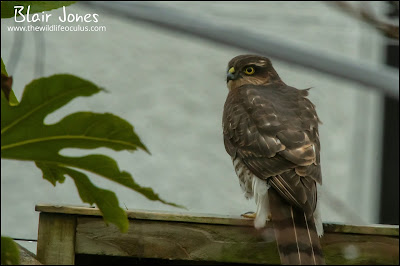Wildlife at home
 |
| The Juvenile Sparrowhawk |
I have a small urban garden. Its nothing special and I will never win any awards for my gardening abilities. There is a square bit of lawn that I occasionally mow in the summer. The grass is quite thick, in places patchy and at times it's like a bog as it gets waterlogged. I have put in my own little pond and planted a few Acer trees and some ornamental bushes.
Then there is a bit of magic I have added. My garden feeders. I have been putting up various feeders for over ten years. I started with one hanging bird feeder from the Acer tree which soon multiplied to several different types. At the moment I have a big hanging seed feeder courtesy of one of my good friends, a fat ball feeder, a hanging bird table and several small feeders.
All of the feeders have to be hung about eye level to prevent the dreaded cats which frequent the neighborhood.
So my gardens bird feeding station should sound quite familiar to anyone that feeds their birds like me - nothing special.
I love the winter when it comes to garden birdwatching. During the summer months, the garden feeders tend to get a little quiet and I don't tend to put much feed out and sometimes stop as there is plenty of food around - especially in the nearby wood so the numbers of feathered visitors start to dwindle before picking up again in the autumn when the weather turns colder. Springtime is also good as many of the birds will have hungry broods to feed and often like to supplement their diet with free mealworms that are available.
The winter months are by far the busiest. I stock up the feeders and do all my birdwatching and photography through the windows that look out at the garden. Taking photographs through double glazing is far from ideal but I have being so for years and have learned how to best deal with it. You need clean windows, get your lens close to the glass and as horizontal as possible. Cloudy days are better than really sunny days as you tend to get less glare from the sun especially if you are south facing.
This week the feeders have been busy. It has been more time wet than sunny and this seems to increase the birds to visit the garden.
I have never seen so many Blue Tits this year. At one point, ten Blue Tits arrived in a flock that also contained two Great Tits, two Coal Tits and six Long Tailed Tits.
 |
| Long Tailed Tit |
The Blue Tits by far outnumber every other species I get to the garden with one exception - the Starlings. If any Starling clocks that I have put mealworms out they will descend from nowhere in droves and gobble everything up greedily.
Dunnocks this winter seem to be scarce. I have only had one or two. There is a Robin around and it's quite territorial so tends to chase after any Dunnock it sees. There are lots of Blackbirds. They seem to be continually battling each other for supremacy.
Two Grey Squirrels visit the feeders regularly. They appear to have totally abandoned hibernating. Not a day has passed without a visit from them.
 |
| Grey Squirrel raiding my new hanging feeder |
 |
| The Sparrowhawk clocked me watching it and gave me the death stare before preening itself. Perhaps its getting used to me. |
I am hoping it keeps coming and eventually starts molting into adult plumage. Then I may get a better idea.
All its visits so dar have not resulted in a kill either. I know that the males tend to specialize in the smaller species of garden birds and females can take anything up to the size of a big wood pigeon.
My second surprise this week was seeing a male Blackcap. That is the first of my year and very much likely to be bird that has opted to brave out the mild winter weather rather than migrate south to Africa.
 |
| Male Blackcap. It likes to feed on the fat balls. |
I am looking forward to the spring as my local wood will come alive with the sound of Blackcaps which tend to sing from the dawn chorus, all day long to dusk.
It is amazing what wildlife a little garden with some well-stocked feeders can attract to it. I cant wait to see what turns up next week.


Comments
Post a Comment